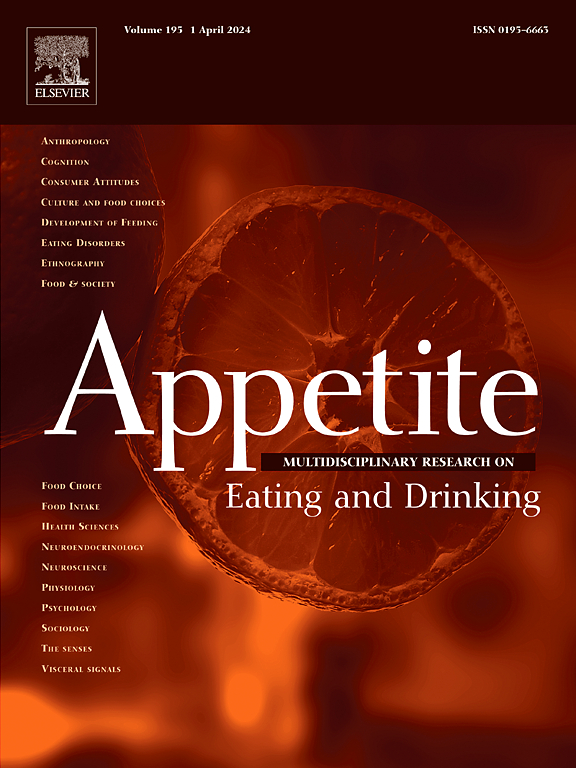智利营养警告标签与营养评分对食品购买意向影响的随机对照试验。
IF 3.8
2区 医学
Q1 BEHAVIORAL SCIENCES
引用次数: 0
摘要
背景:导致肥胖的主要因素是超加工产品的消费。我们的目标是评估包装正面营养警告标签系统与简单的营养红绿灯的有效性,以促进购买新鲜食品和提高家庭购物篮的营养概况。方法:随机对照干预研究在虚拟超市的每周杂货购物篮的样本西班牙成年人。参与者被随机分配到智利警告标签(干预组)或法国营养评分系统(对照组)。在进行模拟购买后,参与者完成了一份关于社会人口变量的调查问卷。为了比较两组的食物和营养状况,我们使用独立样本t检验和多元线性回归分析。结果:共有747名受试者,其中CWL组391人,NS组356人。在新鲜和最低限度加工产品的百分比或营养状况方面,各组之间没有发现差异。与分配给营养评分的参与者相比,分配给警告系统的购物篮中每100克产品的平均能量低6.6千卡(p=0.05),平均蛋白质含量低0.4克(p=0.04)。在二次调整分析中,分配给预警系统的参与者每100 g产品的平均糖含量比分配给营养评分的参与者高0.63 g (p=0.01),平均蛋白质含量低0.44 g (p=0.02)。结论:在西班牙消费者的每周购物篮样本中,新鲜和最低限度加工产品的百分比或营养概况没有发现差异。分配给食品警告标签的参与者的蛋白质含量略低于分配给营养评分系统的参与者。本文章由计算机程序翻译,如有差异,请以英文原文为准。
Randomised controlled trial on the effect of Chilean nutritional warning labels versus nutri-score in food purchasing intentions
Background
The main factor causing obesity is the consumption of ultra-processed products. We aim to evaluate the effectiveness of a front-of-pack nutritional warning label system versus a simple nutritional traffic light for promoting the purchase of fresh foods and enhancing the nutritional profile of the household shopping basket.
Methods
Randomised controlled intervention study of the weekly grocery shopping basket at a virtual supermarket of a sample of Spanish adults. Participants were randomised to the Chilean warning label (intervention group) or French Nutri-Score systems (control group). After making the simulated purchase, the participants completed a questionnaire on socio-demographic variables. To compare the food and nutritional profiles of the two groups, we used the independent samples t-test and multiple linear regression analysis.
Results
There were 747 participants, 391 allocated to the CWL group and 356 to the NS group. No differences were found in the percentage of fresh and minimally processed products or the nutritional profile among groups. Compared to the participants allocated to the Nutri-Score, the mean energy per 100 g of product in the shopping basket of those allocated to the warning system was 6.6 kcal lower (p = 0.05), and the mean protein content was 0,4 g lower (p = 0.04). In secondary adjusted analysis, the mean sugar content per 100 g of product in the participants allocated to the warning system was 0.63 g higher than that of those allocated to the Nutri-Score (p = 0.01), while the mean protein content was 0,44 g lower (p = 0.02).
Conclusion
No differences were found in the percentage of fresh and minimally processed products or the nutritional profile in the weekly shopping basket of a sample of Spanish consumers. The protein content was slightly lower among participants allocated to food warning labels than in those allocated to the Nutri-Score system.
求助全文
通过发布文献求助,成功后即可免费获取论文全文。
去求助
来源期刊

Appetite
医学-行为科学
CiteScore
9.10
自引率
11.10%
发文量
566
审稿时长
13.4 weeks
期刊介绍:
Appetite is an international research journal specializing in cultural, social, psychological, sensory and physiological influences on the selection and intake of foods and drinks. It covers normal and disordered eating and drinking and welcomes studies of both human and non-human animal behaviour toward food. Appetite publishes research reports, reviews and commentaries. Thematic special issues appear regularly. From time to time the journal carries abstracts from professional meetings. Submissions to Appetite are expected to be based primarily on observations directly related to the selection and intake of foods and drinks; papers that are primarily focused on topics such as nutrition or obesity will not be considered unless they specifically make a novel scientific contribution to the understanding of appetite in line with the journal's aims and scope.
 求助内容:
求助内容: 应助结果提醒方式:
应助结果提醒方式:


